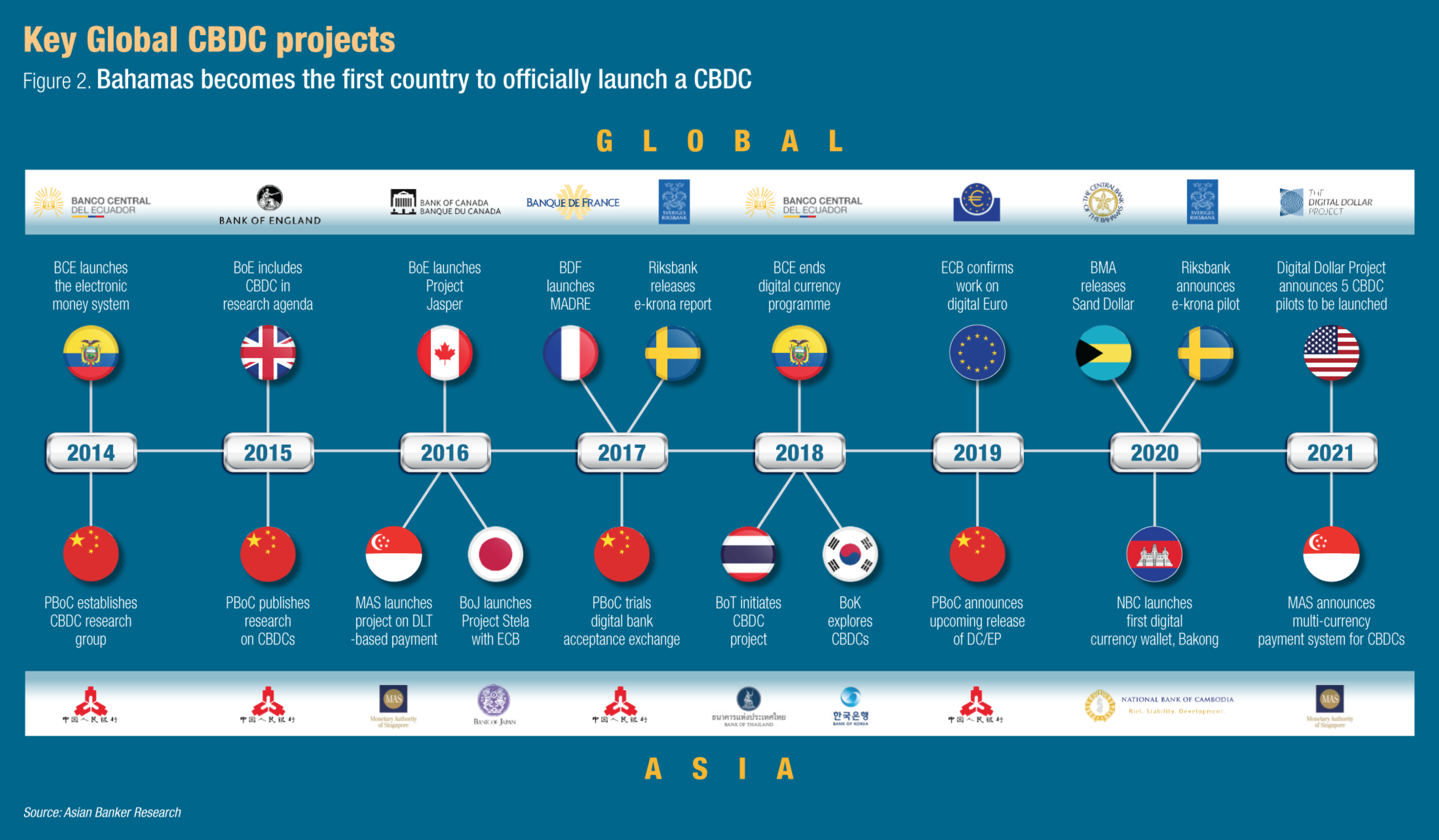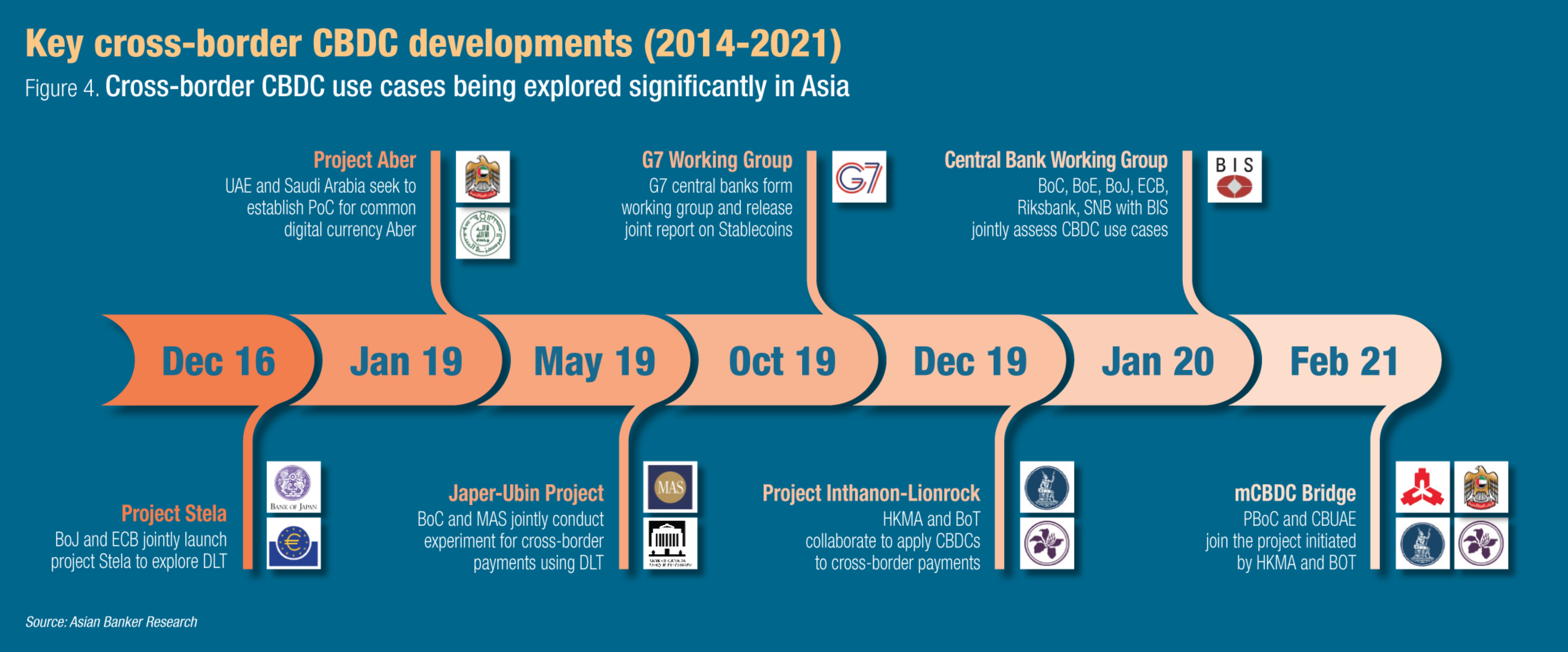Innovation in payment services and the rise of e-commerce platforms have dramatically altered how consumers, merchants and financial intermediaries engage with one another. Coupled with the entry of new market participants, a radical redesign of payment infrastructure and mechanism is underway. Similarly, means of payment are also evolving where money, which for the most part consisted of minted coins and currency notes represented on centralised electronic ledger systems, is now on the cusp of being altered by new forms of decentralised digital currencies.
Prospects of digital currencies centred on speed, transaction cost and trust
A digital currency is essentially an electronic medium of exchange conducted through designated computer networks or platforms. Arguably, digital currencies possess the same properties as their physical counterparts and can be used for settlement of both real-time and cross-border transactions when both parties are connected to the same network.
The benefit that accrue to market participants is the ability to transact directly between counterparties without any intermediaries. This enables low-cost transactions in comparison to conventional payment options that often require correspondent banks and/or clearing houses to complete a transaction. Furthermore, there is greater transparency and visibility of transactions and record-keeping as well as enhanced portability.
Indeed, it was the successful launch and consequential impact of decentralised cryptocurrencies such as Bitcoin and Ethereum that necessitated central banks to rethink their approach to this fast-emerging alternative payment instrument. Regulators have responded via their own central bank digital currency (CBDC)-issued and overseen by respective country central banks with many jurisdictions moving quickly to study and evaluate their potential rollout.

Impact on banks and financial markets likely to be mixed
The impetus for CBDC is understandable given the potential impact private sector-driven digital currency initiatives have on the banking industry and global financial markets. The prospects of faster payments sidestepping automated clearing houses, card-based networks and conventional bank wire transfers, facilitating lower interchange and currency conversion costs and the ability to transact outside traditional settlement hours have made digital currencies attractive.
The greatest value of cryptocurrencies and related decentralised financial system comprising crypto exchanges, trading platforms and custodian, is their ability to engender trust between counterparties given the absence of intermediaries as well as full visibility and immutability of transactions embedded in the underlying blockchain or distributed ledger.
Perhaps greater than its potential as a trusted medium of exchange, cryptocurrency has also proven its qualities as a store of value, that is not affected by the vagary of central banks’ monetary policies, government policies or sanctions and to a lesser extent manipulation by traders and speculators. It would arguably contribute to greater payment stability and market efficiency. By extension, through a decentralised network, payments can also be made available and accessible to those outside the formal banking and financial system.
The proof that cryptocurrencies can be a good store of value has attracted the attention of investors, speculators and contributed to the rise and volatility of digital asset prices, especially mainstays such as Bitcoin and Ethereum. The demand for such alternatives has grown in markets where depositors and investors have seen the value of their own fiat-based domestic currencies plummet due to inflation, quantitative easing, thereby further accentuating the appeal of digital currencies.
Cryptocurrencies are also fast emerging as an asset class on their own given their lack of correlation with other investment instruments. Their comparatively smaller capitalisation at this stage make them less likely sources of systemic risk despite becoming increasingly favoured by “hot-money” speculators.
The entry of stablecoins, variants of cryptocurrencies that are pegged to widely used fiat currencies or commodities, is welcomed by market participants as they provide much needed stability. One to watch out for is Diem (formerly known as Libra) that currently remains under development by Facebook. The social media giant will issue the cryptocurrency into the e-wallets of Facebook users against US dollar deposits with the Diem foundation. Even if a fraction of the 2.8 billion users or merchants were to adopt the stablecoin, the impact could be substantial.
However, it is necessary to acknowledge that today’s cryptocurrencies and even stablecoins may not be entirely perfect substitutes or proxies for fiat currencies. Capacity and processing power considerations aside from the recent exuberance with Dogecoin raise questions as to what will happen if the market loses confidence in a particular digital currency or worse, if there is a run on the digital currency. It is here where CBDCs offer the most value and serve a wider financial market and monetary system stabilisation purpose.

CBDC developments gather momentum
Central banks have been undertaking extensive research on digital currencies to improve the cost, security, speed and reach of transactions in order to facilitate the creation and adoption of more effective cashless ecosystems. More than a year after the start of the COVID-19 pandemic, central banks and policymakers are not only advancing digital currencies research from concept, but also speeding up the launch of pilot programmes for implementation especially as the crisis has hastened the switch to digital and remote transactions by four to five years.
The results of the third Bank of International Settlements (BIS) survey conducted in January 2021 revealed that 86% of central banks are now exploring the benefits and drawbacks of CBDCs, up from 80% in 2020 and 70% in 2018. It has published a multitude of in-depth assessments and policy implications over its technical designs. The survey also found that 60% of central banks have progressed from conceptual research to experimentation, up from 40% in 2020, while another 14% have developed pilot projects, an increase of 10% over the previous year.
A case in point is the launch of Sand Dollar by the Central Bank of Bahamas which it claimed as the world’s first “live” CBDC issued to residents. It was launched in October 2020 after a successful pilot in 2019. Sand Dollar is the digital version of the Bahamian dollar (BSD) and as such the liability of the central bank, issued through six authorised financial institutions (AFIs), mostly money transmission businesses and payment service providers (PSPs) which possess the technology to offer mobile wallets. Primary purposes are to provide and promote a more inclusive access to regulated payments for unbanked and underbanked communities and reduce transactional costs across the 700 islands of Bahamas. “There is a great deal of promising innovation in the digital currency/payment space that will reduce friction and associated costs of transactions while increasing access or inclusion,” said Michael Demissie, head of advanced solutions at BNY Mellon.

Michael Demissie,
Head of Advanced Solutions,
BNY Mellon

Sandeep Malhotra,
EVP of Products and Innovation,
Asia Pacific, Mastercard
Michael Demissie, Head of Advanced Solutions, BNY Mellon
For wider interoperability with card issuers and merchants, the licensed digital payment platform, Island Pay, partnered with Mastercard to issue the first-ever prepaid card linked to a CBDC in February 2021, giving residents the option to instantly convert Sand Dollars to Bahamian dollars anywhere Mastercard is accepted around the world. According to Sandeep Malhotra, executive vice president of products and innovation in Asia Pacific at Mastercard, “CBDCs offer great potential to bring more people into the digital financial system, offering fast access to currency for populations where the circulation of physical cash may be more limited due to limited physical infrastructure, e.g., ATMs”. Mastercard has created a CBDC testing platform to offer support to central banks as they begin to explore the technology that he believes is poised for greater acceptance and offers the broadest impact.
Sandeep Malhotra, EVP of Products and Innovation, Asia Pacific, Mastercard
Having constructed the infrastructure for its digital currency and electronic payment (DCEP) system, the People’s Bank of China (PBOC) has become the first central bank to introduce the digital renminbi (RMB) through the launch of a trial which was carried out last year between April and August in four Chinese cities of Shenzhen, Suzhou, Chengdu and Xiong’an primarily for retail purposes. In Shenzhen, the trial culminated in the distribution of $1.6 million (RMB 10 million) to the digital RMB wallets of 50,000 randomly selected Shenzhen residents. Statistics from the trial showed that it is the most widely used CBDC in a commercial setting. PBOC created 113,300 consumer digital wallets and 8,859 corporate digital wallets for residents and businesses in Shenzhen, Suzhou and Xiong’an to pilot the digital RMB. The digital wallets processed $162 million (RMB 1.1 billion) through 3.1 million transactions between April and August 2020.
In one of the controlled experiments in February 2021, Beijing and Suzhou issued $6.2 million (RMB 40 million) over the Lunar New Year holiday period in digital red packets (each worth RMB 200, $31) that were distributed via a random draw. The test was done via JD.com’s online mall, making it the first virtual platform to accept China’s digital currency. Further plans include the 2022 Beijing Winter Olympic Games where foreign athletes and visitors will have a chance to use digital RMB.
One of the reasons that Chinese authorities have accelerated the pace of CBDC rollout is to develop a state-run alternative to existing mobile payment platforms dominated by Alibaba’s Alipay and Tencent’s WeChat Pay. Combined, they control roughly 95% of the digital payments market where 85% of retail payments today are through digital modes.
Despite the noise around the state’s strict oversight of private digital ecosystems, PBOC has also been working with payment players like Alipay and WeChat Pay as well as ride-hailing, food delivery segments, especially as they sign up as “strategic partners”, likely to be integrated in the DCEP. In fact, Tencent-backed WeBank and Ant-backed MyBank would participate in the digital RMB pilots alongside the six major state banks, making them critical tools for the government to accelerate China’s cashless transformation.
On the wholesale side, China is the first to add digital currency-related content to the repository for ISO 20022, the new global standard covering financial information transferred between financial institutions that includes payment transactions, securities trading and settlement information.
Outside of China, Sweden’s “e-krona” pilot appears to be the most advanced where the Sveriges Riksbank has started a trial. In 2020, Sweden reported its lowest cash usage ever. Less than one-tenth of all payments were made by cash while 75% of people in Sweden have paid using the Swiss app. “As with the rapid decline in cash usage, it’s important that the Riksbank examines the possibility to upgrade to more digital means of payments,” commented Mithra Sundberg, head of the e-krona pilot division at Riksbank.

Mithra Sundberg,
Head of e-krona Pilot Division,
Riksbank

Chan Boon-Hiong,
Global Head of Securities Market and Technology Advocacy,
Deutsche Bank
Mithra Sundberg, Head of e-krona Pilot Division, Riksbank
It conducted a pilot project with Accenture in February 2020 on R3’s Corda blockchain platform to develop a technical solution for an e-krona that can work as a complement to cash. The tested solution is based on blockchain and distributed ledger technology (DLT). The main purpose of the pilot is to determine what form a CBDC might take and how an e-krona could be used by the general public. “We are still in the stage where we are examining the possibilities of e-krona and we want to know in what best way it can be implemented,” added Sundberg. However, she was quick to clarify that no decision has been made on the e-krona’s technical design or if it will be based on any particular blockchain or DLT.
The first leg of the trial revealed the need to scale the underlying technology to manage retail and offline payments. The next phase will include potential issuers and acquirers of e-krona to test network integration. “In 2021, we are trying to integrate a few PSPs into the e-krona network and test the solution with them. We want to eventually test scalability on how it can handle mass payments in a secured manner,” she said.
Riksbank has not made public the timeline of the e-krona launch and notes there are political considerations as well. “There is a governmental enquiry going on for e-krona’s role in the payment market, which is expected to be finalised by November 2022,” added Sundberg. She enthused that the timeline will give them “enough time to prepare and continue with their progress”.
“Central bank-issued digital currencies are globally in experimental and pilot stages, although the Bahamas, China, and Sweden appear to be in more advanced stages in this transformative development,” said Chan Boon-Hiong, global head of securities market and technology advocacy at Deutsche Bank.
With China accelerating its plans for digital currency implementation, the Federal Reserve (the Fed) is monitoring global CBDC developments with a ‘wait and rather getting it right approach’.
Chan Boon-Hiong, Global Head of Securities Market and Technology Advocacy, Deutsche Bank
It announced the upcoming release of a research paper outlining its response to innovation in global digital payments and the potential benefits and risks of issuing a US CBDC for American households and businesses.
Meanwhile, the Federal Reserve Bank of Boston is exploring the use of existing and new technologies to build and test a hypothetical digital currency platform for general purpose use. The project was launched in collaboration with the Digital Currency Institute at the Massachusetts Institute of Technology in August 2020.

In Asia, central banks are moving towards making cross-border CBDCs interoperable
CBDCs have the potential to enhance the efficiency of cross-border payments without the need for a global unit of account as being explored under global stablecoin arrangements. Interoperability between national CBDCs and interlinking of national payment systems may be achieved in multi-CBDC (mCBDC) Bridge arrangements which can improve the interaction of CBDCs across borders and remove frictions from today’s correspondent banking system. mCBDC Bridge links wholesale CBDCs to form corridor networks and allow real-time transfers using the DLT capabilities. The arrangement will benefit especially emerging market economies that have a poor functioning correspondent banking system. “Globally coordinated CBDC design efforts and mCBDC arrangements will also offer a worthy alternative to privately-issued stablecoins or cryptocurrencies which are not coordinated internationally with societal objectives in mind,” said Agustin Carstens, general manager at BIS.
Although the work is preliminary, interlinking of CBDCs are gaining traction. “I am convinced that the future of the international financial system relies on fostering the seamless convertibility of one sovereign currency into another and this is precisely the solution that central banks have pursued for many years and are continuing to pursue,” he added.
There have been a number of cross-jurisdictional projects to explore the feasibility of cross-border digital currency transactions. The Digital Currency Institute (DCI) of PBOC and the Central Bank of the United Arab Emirates (CBUAE) have joined a CBDC project for cross-border foreign currency payments. In November 2020, the UAE had successfully completed a wholesale CBDC proof of concept with “Project Aber” with the Saudi Central Bank to settle domestic as well as cross-border commercial bank transactions between the two countries using DLT.
Separately, the Hong Kong Monetary Authority (HKMA) and the Bank of Thailand (BOT) launched in May 2019 Project Inthanon-LionRock, a Thai baht-Hong Kong dollar corridor network with 10 participating banks from both countries. The project explored the capabilities of DLT to support real-time 24/7 cross-border foreign exchange (FX) payment-versus-payment transactions in multiple jurisdictions. Whether such cross-border developments will disintermediate or transform the role of correspondent banks remains debatable. Chan argued that between the wider adoption of peer to peer (P2P) transfer in cross-border remittances, the core role of banks remain highly relevant. He explained, “P2P and direct linkages can also be between central banks to bridge cross-border remittances, facilitate financial inclusion, reduce costs, and reduce de-risking concerns e.g., the BOT-HKMA CBDC experiment. Therefore, direct linkages do not necessarily mean disintermediation of commercial banks”.
Notably, the second phase of Project Inthanon-LionRock involves HKMA and BOT joining the CBUAE and the PBOC DCI. It became a project under the BIS Innovation Hub Centre in Hong Kong in February 2021 and was renamed mCBDC Bridge. Together, the four central banks will evaluate the feasibility of the mCBDC Bridge for cross-border fund transfers, international trade settlement and capital market transactions which could benefit the whole financial ecosystem. ConsenSys, a developer of decentralised payment networks, is providing the technology behind the mCBDC Bridge project. Charles d’Haussy, its director of strategic Initiatives in Hong Kong, remarked, “Regulators, financial institutions (FIs) and digital players have started to collaborate in major projects such as the mCBDC Bridge”.

Charles d’Haussy,
Director of Strategic Initiatives,
ConsenSys Hong Kong

Piyush Gupta, DBS
Group CEO,
Charles d’Haussy, Director of Strategic Initiatives, ConsenSys Hong Kong
As CBDC-based systems must co-exist and be integrated with other payment systems, SWIFT has set up a CBDC and digital asset innovation project with Accenture in November 2020 to understand the impact on its 11,000 institution members and 4 billion accounts globally. As part of its first study phase in cross-border payment, it explores the interlinking of cross-border CBDC networks over existing payment infrastructure, and how new solutions, both DLT and non-DLT, may become extensions of current infrastructure.
DLT-based payment joint ventures to accelerate cross-border CBDC use cases
While real-time domestic payments have become commonplace, the clearing and settlement of securities still follow a T+2 (transaction date plus two days) cycle and cross-border payments continue to require days to complete, due mainly to inefficiencies in the current correspondent banking model. Relying on multiple bilateral corresponding banking relationships across countries/corridors has worked until now, but it is not ideal and comes with significant operational limitations.
Perhaps, application of blockchain and DLT could challenge the cumbersome hub-and-spoke model that applies to traditional cross-border payment flows. Piyush Gupta, CEO at DBS, sees this as a game changer in settlement of security, FX and payment. “What the blockchain lets you do is democratise it at scale for any counterparty in the world and therefore, anybody on this platform can effectively pay in real-time,” he commented.
Piyush Gupta, Group CEO, DBS
While he echoed the industry’s challenges around the adoption of the technology, he is optimistic that the support from central banks such as the Monetary Authority of Singapore (MAS) would go a long way in making its use more widespread. “MAS is a big participant of Project Ubin and it is talking to other central banks and agencies to see how we could actually push the platform and make it generically available,” he said.
As part of MAS’ fifth and final phase of Project Ubin, DBS, JP Morgan and Temasek have come together to develop a blockchain platform for clearing and settlement of cross-border multi-currency payments. The new joint venture known as Partior will initially be available to banks based in Singapore, with plans to expand access to other FIs at a later stage. Partior was tested in Singapore and US dollar-based transactions with yen, euro and RMB (should PBOC allow) in the pipeline. The project has identified 16 use cases across capital markets, trade and supply chain finance, insurance and in areas beyond financial services such as media, healthcare, and payroll. Interoperability in the project is enabled by front end interfaces – “wallets” to Ubin V as well as other platforms.
In addition, Siam Commercial Bank’s (SCB) Blockchain for Procure-to-Pay (B2P) platform was integrated with the Ubin payments network to allow buyers, sellers and banks to exchange trade documents and settle trade transactions. The B2P is powered by Corda’s DLT and is funded by SCB’s venture capital subsidiary Digital Ventures. It improves process efficiencies for sellers to access supply chain financing through automated trade document exchange and verification.
The Ubin payment platform uses Quorum (acquired by ConsenSys) blockchain infrastructure, developed as part of JP Morgan’s Liink- a scalable P2P blockchain network, formerly known as Interbank Information Network (IIN), under a new subsidiary called Onyx. It is part of JP Morgan’s blockchain and next generation technology offerings which also include its own digital currency, JPM Coin. Liink has signed up over 400 banks, of which over 100 have gone live. Some including the likes of State Bank of India, Bank Negara Indonesia, CTBC Bank, are trialling use cases in remittances.
Impact on domestic and cross-border settlement, liquidity reconciliation and risk necessitate rethink by traditional players
Whether digital currencies truly present game-changing opportunities for revolutionising existing payment infrastructures remain to be seen. Michael Bellacosa, managing director and head of global payments at BNY Mellon Treasury Services remarked that it will take time for adoption to take place. “There is likely to be a more limited adoption in the short-to-mid-term as digital payment ecosystems tend to not have broad participation. In general, where reach is required, transactions move back to traditional channels in order to execute the movement of funds to the beneficiaries account through their legacy financial institutions.”

Michael Bellacosa,
MD and Head of Global Payments,
BNY Mellon Treasury Services

Ciyi Lim,
Head of Innovation,
Asia Pacific, Visa
Michael Bellacosa, MD and Head of Global Payments, BNY Mellon Treasury Services
Similarly, on the need for standardisation to facilitate reconciliation, Chan highlighted, “The market characteristics that act as a context to the use of digital currencies are equally important factors to be considered before practical benefits can be crystallised. A lack of data standardisation, unstructured data or truncated data will still challenge reconciliation efforts even if reconciliation is digital and automated”.
Likewise, Charles d’Haussy, director of strategic initiatives at ConsenSys Hong Kong, observed, “The application of retail CBDC to mobile money has the potential to foster greater interoperability, improve payment efficiency, facilitate cost-saving gains by minimising reconciliation complexity, as well as reduce the key payment risks”.
From a liquidity management perspective, digital currencies will enable transition to an instant payment model through the use of digital tokens. d’Haussy stated, “Corporate banks and financial institutions are seeking to have safe and secured platforms to enable more robust measuring and monitoring of their liquidity. Digital currency allows banks to have secured networks and enable a real-time, end of day liquidity management system”.
Bank treasury departments will have to reorient their existing approach to intraday liquidity management and optimisation to ensure that the requisite funds are available to initiate transactions given the T-instant environment. Importantly, Chan remarked, “Ad hoc bullet payments with large value will still challenge liquidity management regardless of whether or not digital currencies are used”.

Redefining the role of correspondent banks as payment enablers and settlement providers
Certainly, the way cross-border transactions are conducted today are very likely to change in the medium to long-term. Correspondent banking is still used to facilitate retail and wholesale payments that involve multiple actors in ensuring front to back end execution of transactions which naturally carry additional cost implications complicated by risk factors that range from counterparty and institutional risk to locked capital held in accounts.
Correspondent banking will still have relevance provided they are prepared to adapt to emerging market realities. Bellacosa observed, “New digital currencies have a complex ‘multipath’ and definitely not a straight line forward. The role of correspondents will need to evolve to support these changes”. “Strong intermediaries will maintain the connectivity to the legacy and provide the linkages to the emerging platforms that are developed and yet to be developed,” he added. This can prove to be essential considerations for a more sustainable business model that can maintain and generate new revenue streams.
Ciyi Lim, head of innovation for Asia Pacific at Visa, reinforced this notion and said, “While earlier designs of CBDC had considered having the public directly open accounts with the central banks, nearly all models now opt to leverage commercial banks as an intermediary. As a result, it is likely that CBDCs will complement rather than replace existing payment infrastructure. We expect CBDC to mould itself into the payment habits of consumers and businesses and co-exist alongside current payment methods”.
Ciyi Lim, Head of Innovation, Asia Pacific, Visa
This perspective is consistent with BIS’ Carstens who said, “Retail CBDCs grab more attention as these would give the general public a digital means to access central bank money and could be a new form of “digital cash”, complementing physical cash”.

Agustin Carstens,
General Manager,
BIS
Adapting to the new monetary environment requires cross–stakeholder engagement and partnerships
It remains to be seen how quickly the various stakeholders in the broader banking and financial system can adapt. Digital currencies are fast becoming a reality and it is now a question of how the industry and supporting financial market infrastructure can embrace and leverage this disruptive innovation.
For their part, central banks recognise that unless they are willing to cede space and control of the monetary system to private sector cryptocurrencies/stable coins and virtual currencies they will have to introduce their own variant of digital currencies or CBDCs. Commercial banks have responded positively by either becoming enablers for cryptocurrency transactions or utilising stablecoins. The JPM Coin, a US dollar-pegged stablecoin, launched by JP Morgan in February 2019 is a case in point.
It is likely that as the digital currencies landscape evolves and the rollout of various CBDCs begins to gain traction, market participants will benefit from the wider range of payment instruments on offer. High performing cryptocurrencies and stablecoins that lend themselves for mass acceptance and adoption or possess unique use cases will continue to remain of interest and exist along their CBDC counterparts.
Lim opined, “For stablecoins, there could be potential for new use cases and value-added services such as trade settlement for digital commodities, new payment flows such as business-to-business (B2B), peer-to-peer payments and disbursements. For CBDC, it could help promote financial inclusion and strengthen public access to central banks as cash declines. Its accessibility and interoperability may encourage greater innovation for value-added services than existing payment modes”.
The way forward for all market participants has been relatively clearly informed by studies and research by authorities such as the BIS. The impetus remains on national governments and regulators to provide the frameworks that will govern its operation domestically while collaborating with international peers to establish global standards as a requisite for interoperability. Banks will need to transform their existing business models and reimagine their position as financial intermediaries within the payments system.
Chan observed, “What can hold banks back from being competitive – and this is at the root of disintermediation concerns – is whether they have identified the developing spaces that they want to focus on, what skills and insights they need to develop internally, and the time they need to evolve existing business and risk acceptance basis to be fit-for-purpose to capture new opportunities; rather than relying too long on an old lens to look at new growth characteristics, resulting in them saying ‘no’”.
Fundamentally, any long-term success will require deep stakeholder engagement by all market participants and ultimately CBDCs may eventually win out due to state backing seeking preservation and sovereignty of their respective monetary regimes. Perhaps, it is the digitisation of fiat money that offers the path of least resistance for private sector players. Gupta opined, “I do think the regulatory forbearance is much better than if you start trying to create a new currency”.
Recognising this reality requires public and private sector partnership and as Malhotra suggested, “A ‘two-tier’ CBDC architecture would ensure that the central bank retains institutional governance over core monetary infrastructure, while relying on private sector participation from banks and fintechs to compete in the distribution and circulation of the CBDC and the development of innovative user experiences and use cases”.


.png)






























